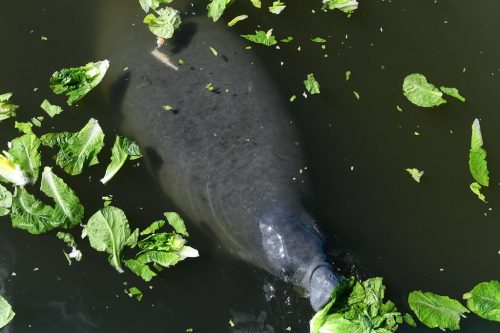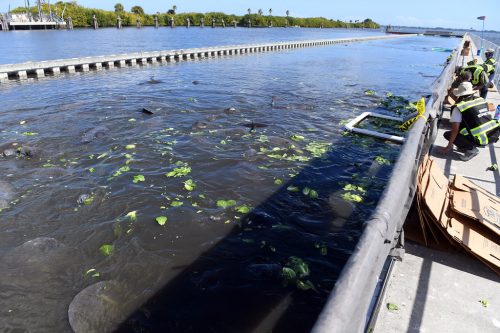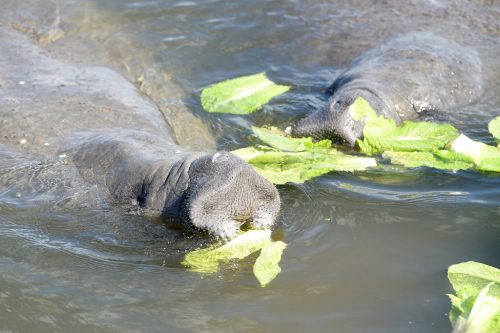Sharpes, Florida —(Map)
In an unusual move, wildlife workers in Florida are feeding manatees to keep them from starving. But feeding these massive sea creatures takes a lot of food. So far, the rescue workers have already given out 25 tons of lettuce.
Manatees are huge sea mammals that can be as long as 13 feet (4.0 meters) when grown. They can weigh up to 1,300 pounds (590 kilograms). In spite of their size, manatees only eat sea grass and other plants that live in the sea. That’s one reason they’re sometimes called “sea cows”. They spend most of their time in warm, shallow water looking for food.

(Source: Florida Fish and Wildlife, via Flickr.com.)
But Florida’s manatees have been on the US government’s list of endangered animals since 1967. Most threats to manatees come from humans. One of the biggest problems facing the creatures are boats. Manatees are curious, and fairly slow. That has led to thousands of manatees being injured or killed by boats and their propellers.
With protection, manatees managed to bounce back. At one point, there were only about 2,000 manatees left in Florida. But by 2016, there were roughly 8,800 manatees.
But now manatees are facing a new challenge: they can’t get enough to eat. Many of the beds of sea grass that manatees depend upon have been killed by human-caused pollution.
😕
This image has not been loaded because of your cookie choices. To view the content, you can accept 'Non-necessary' cookies.
But now manatees are facing a new challenge: they can’t get enough to eat. Many of the beds of sea grass that manatees depend upon have been killed by human-caused pollution. Above, a manatee near a recently restored bed of sea grass in the Homosassa River.
Sea grass began to disappear around 2011. Warming seas, combined with polluted water and fertilizers that have washed off of farmlands have created huge growths of algae on the ocean’s surface. The algae blocks the sunlight that allows the sea grass to grow.
The problem is especially serious in Indian River Lagoon. That’s a protected area where manatees often go in the winter because the water is warmer. About 90% of the sea grass beds in the area have died off.
Last year, 1,101 manatees died. That was a record. Most died from starving to death. Many of the manatees that remain are so thin that their ribs can be seen. Often they have trouble swimming.

(Source: Florida Fish and Wildlife, via Flickr.com.)
So last December, government wildlife experts came up with a plan to get emergency food to the manatees. They decided to feed them green vegetables like lettuce and cabbage.
As a feeding spot, they chose a part of the Indian River Lagoon where Florida Power & Light has a power plant. The power plant releases warm (clean) water, so it’s popular with the manatees.
The feeding station has been very successful. Around 350 manatees a day have come to get food. On some days, as many as 800 manatees have shown up.

(Source: Florida Fish and Wildlife, via Flickr.com.)
Last week, wildlife workers reported that they had given out a total of 50,000 pounds (22,700 kilograms) of lettuce. Ron Mezich, who works with the Florida Fish and Wildlife Conservation Commission, said, “We’re making a difference.”
Even so, scientists worry that hundreds more manatees could starve this winter.
Long term, Florida is working to help restore sea grass beds. But that will take time. The state has set aside $8 million for the effort, which is still being planned.
Did You Know…?
Wildlife experts say it’s important that other people not try to feed manatees. Instead, they suggest that people who want to help should give money. One place to donate is the Fish and Wildlife Foundation of Florida, which is helping to pay for the feeding program.
😕
This map has not been loaded because of your cookie choices. To view the content, you can accept 'Non-necessary' cookies.
